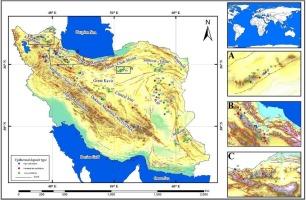Stable isotope, fluid inclusion, and petrological-mineralogical features of epithermal deposits in the structural zones of Iran: A review
IF 3.6
2区 地球科学
Q1 GEOLOGY
引用次数: 0
Abstract
The structural zones of Iran and their various subtypes of epithermal deposits are: Urumieh-Dokhtar (LS-IS-HS), Arasbaran (LS-IS-HS), Alborz [Tarom (LS-IS-HS), Torud-Chah Shirin (LS-IS-HS), Binalood (LS) subzones], Sabzevar-Taknar (LS), Sanandaj-Sirjan (IS-HS), Makran (LS), Lut (LS-IS-HS), and Central Iran (LS-IS). One hundred and sixteen epithermal deposits in Iran are reviewed in this article. There are two or three subtypes in all zones except Sabzevar-Taknar and Makran. The majority of the host rocks consist of Eocene-Oligocene volcanic, pyroclastic, and intrusive rocks with calc-alkaline, high-K calc-alkaline, and shoshonitic affinities in the continental magmatic arc in a subduction zone. The Central Iran host rocks are the most different. Based on isotope studies, the O and H sources are mostly magmatic and then meteoric water, but in some LS deposits, formation waters played a role. In the LS deposits, C sources are magmatic, meteoric, marine carbonate, and sedimentary. Sulfur sources are mostly magmatic, but sedimentary, volcanic-sedimentary series, igneous, marine evaporate sulfate, evaporate, and sedimentary-metamorphic basement. In the IS deposits, S sources are sedimentary, igneous, magmatic, and volcanic H2S. In the HS deposits, S sources are sedimentary, volcanic-sedimentary series, igneous, magmatic, magmatic vapors, and volcanic H2S. There are L + V, L1 + L2 + V, V + L, L, V, L + V + S, and L + V + CO2 fluid inclusion types, and precipitation mechanisms in order of importance are boiling, mixing, cooling, and dilution. Makran and then Sabzevar-Taknar deposits exhibit the lowest temperature and salinity. According to all the pieces of evidence, the structural setting of the zones determines the characteristics of the deposits, like host rocks, ore-bearing fluid conditions, ore mineral assemblage, alteration, S, O, H, and C sources, and finally, deposit subtypes. In some deposits, shreds of evidence like higher fluid inclusion maximum homogenization temperature, and salinity relative to epithermal range, potassic alteration (biotite-rich), and adakite magma affinity indicate that other types of mineralization (probably porphyry) are associated.

伊朗构造带浅成热液矿床稳定同位素、流体包裹体及岩石矿物学特征综述
伊朗的构造带及其不同类型的浅成热液矿床有:乌鲁木齐-多赫塔尔(LS-IS-HS)、阿拉斯巴兰(LS-IS-HS)、阿尔博兹[Tarom (LS-IS-HS)]、托鲁德-查希林(LS-IS-HS)、Binalood (LS)亚带]、Sabzevar-Taknar (LS)、Sanandaj-Sirjan (IS-HS)、Makran (LS)、Lut (LS-IS-HS)和伊朗中部(LS- is)。本文综述了伊朗116个浅成低温热液矿床。除Sabzevar-Taknar和Makran外,所有区域都有两到三个亚型。主要寄主岩为俯冲带大陆岩浆弧内始新统—渐新统火山岩、火山碎屑岩和侵入岩,具有钙碱性、高钾钙碱性和松玄岩亲缘关系。伊朗中部的宿主岩是最不同的。同位素研究表明,O和H的来源主要是岩浆水,其次是大气水,但在一些LS矿床中,地层水也起了作用。在LS矿床中,碳源主要为岩浆、大气、海相碳酸盐岩和沉积。硫的来源主要是岩浆,但也有沉积、火山-沉积系列、火成岩、海相蒸发硫酸盐、蒸发和沉积-变质基底。在IS矿床中,硫化氢的来源主要有沉积硫化氢、火成岩硫化氢、岩浆硫化氢和火山硫化氢。硫化氢矿床的硫化氢来源主要为沉积、火山-沉积系列、火成岩、岩浆、岩浆蒸汽和火山硫化氢。存在L + V、L1 + L2 + V、V + L、L、V、L + V + S和L + V + CO2流体包裹体类型,沉淀机制的重要性依次为沸腾、混合、冷却和稀释。Makran和Sabzevar-Taknar矿床表现出最低的温度和盐度。综合各项证据,构造环境决定了矿床的赋存岩、含矿流体条件、矿石矿物组合、蚀变、S、O、H、C来源及矿床亚型等特征。在一些矿床中,较高的流体包裹体、最高均一温度、相对于浅成热液范围的盐度、钾蚀变(富含黑云母)和埃达岩岩浆亲和等证据表明,与其他类型的成矿(可能是斑岩)有关。
本文章由计算机程序翻译,如有差异,请以英文原文为准。
求助全文
约1分钟内获得全文
求助全文
来源期刊

Ore Geology Reviews
地学-地质学
CiteScore
6.50
自引率
27.30%
发文量
546
审稿时长
22.9 weeks
期刊介绍:
Ore Geology Reviews aims to familiarize all earth scientists with recent advances in a number of interconnected disciplines related to the study of, and search for, ore deposits. The reviews range from brief to longer contributions, but the journal preferentially publishes manuscripts that fill the niche between the commonly shorter journal articles and the comprehensive book coverages, and thus has a special appeal to many authors and readers.
 求助内容:
求助内容: 应助结果提醒方式:
应助结果提醒方式:


